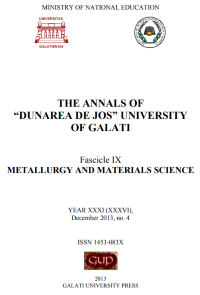Analysis of Dental Alloys Characteristics (Microstructure and Corrosion Resistance) for Different Obtaining Methods
Abstract
A dental alloy was studied by electro-chemical polarization method, scanning electrons microscopy (S.E.M.) and X-ray dispersive energy analysis (EDAX) equipments analyzing the influence of casting process on microstructure and corrosion behaviour. These studies present that in natural aerated Afnor solution saliva this alloy behaves as a corrosion resistant alloy. By casting, this alloy undergoes a significant modifications of both internal microstructure and corrosion resistance. Using over-potentials bigger than five hundred mV (SCE) in artificial saliva this alloy exhibits a generalized corrosion, the surface morphology being dissimilar for commercial and as-cast samples. EDAX studies point out that corrosion takes place especially by cobalt dissolution.
Downloads
References
[2]. Wataha J. C., Alloys for prosthodontic restorations, J Prosthet Dent. 87, 2002, p. 351-63.
[3]. Dong H., Nagamatsu Y., Chen K. K., Tajima K., Kakigawa H., Shi S., Corrosion behavior of dental alloys in various types of electrolyzed water, Dent Mater J, 22 2003, p. 482-93.
[4]. Luthy H., Marinello C. P., Reclaru L., Sharer P., Corrosion considerations in the brazing repair of cobalt based partial dentures, J Prosthet Dent, 75, 1996, p. 515-24.
[5]. German R., The role of microstructure in the tarnish of lowgold alloys, Mettallography, 14, 1981, p. 253-266.
[6]. Hero H., Jorgensen R., Tarnishing of low/gold dental alloy in different structural states, J. Dent. Res., 63, 3, 1983, p. 371-376.
[7]. Venugopalan R., Gaydon J., A review of corrosion behaviour of surgical implant alloys. Dept. of Biomedical Engineering, University of Alabama at Birmingham, Technical Review Note, Princeton Applied Research, USA, 2001.
[8]. Strandman E., Influence of different types of acetylene-oxygen flames on the carbon content of a dental Co-Cr alloy, Odontol Revy, 28, 3, 1976, p. 223-238.
[9]. Oliveira Bauer J. S., Loguericio A. D., Reis A., Filho L. E. R., Microhardness of Ni-Cr alloys under different casting conditions, Braz Oral Res, 20, 1, 2006, p. 40-46.
[10]. Bane M., Analiza structurii materialelor metalice (The analysis of the structure of metallic materials), Editura Tehnicã, Bucharest, 1991, p. 184.
[11]. Giacomelli F. C., Giacomelli C., Spinelly A., Behaviour of a Co-Cr-Mo Biomaterial in simulated body fluid solutions studied by electrochemical and surface analysis techniques, J. Braz. Chem. Soc., 15, 4, 2004, p. 541-547.



